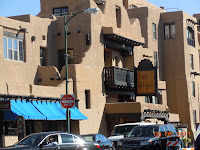 |
| Woman's Fancy manta, public domain |
There's some interesting history that might explain how the Navajo's learned the craft from the nearby pueblo peoples.While historians can document that the two different tribes did not exactly get along because of Navajo raids into pueblo territory, it appears that the two tribes did indeed forge some type of friendship after the Conquistadors entered the picture. The pueblo Indians were put into a kind of forced servitude during the first Spanish occupation of Nuevo Mexico which resulted in the bloody Pueblo Revolt of 1680. It was during and after this revolt that many pueblo Indians fled westward to the land of the Navajo.
The earliest pieces of Navajo weaving which can be dated and that are still exist today come to us from Massacre Cave in Canon del Muerto. Pieces of Navajo weaving dating to the years 1804-05 when the punitive slaughter took place in the Canon, were found circa 1900. These pieces contain a plain stripe pattern in the blanket's designs. This is considered a Navajo adaptation of the Pueblo teacher's style of design.
 |
| Rug door on Navajo winter hogan,1880-1910 |
Commerce increased for the Navajo and the selling of Navajo blankets and Navajo rugs after the opening of the Santa Fe Trail in 1822. The first products on the market were blankets rather than rugs. The change to rugs happened circa 1880.
Today, there is a large market for the Navajo rug and and the Navajo blanket and many Navajo's are involved in it's commercialization. These genuine Navajo rug products today might sell for $800 and for many Navajo's this business represents their sole income. The only real obstacle for their rug industry are the many foreign imitations that are found in many shops. It's important to know what you're buying and while there are certainly many top-notch dealers of genuine Navajo rugs in the Santa Fe and surrounding area, one excellent auction venue in particular, the Crownpoint Auction, will allow you to buy the real thing directly on the Navajo reservation.
Auctions are held usually the second Friday of each month on the Navajo reservation. The auctions is planned to start at about 7 pm and ends around 10 pm. Payment is accepted in cash, traveler checks or personal checks. The auction does not accept credit cards. The auction itself is held at the Crownpoint Elementary School in the small town of Crownpoint. The town is located about 25 miles north of Thoreau New Mexico on NM 371. The Thoreau exit on Interstate-40 is #53. Thoreau is located between gallup and Grants New Mexico. If you're in Santa Fe or on Interstate-40 in New Mexico on the auction dates, a visit to the Crownpoint Auction makes a very unique and rewarding side trip.
Buyers at the Crownpoint Rug Auction have the unique opportunity to purchase Navajo rugs directly from the weavers themselves and prices that are well below retail. The Crownpoint Rug Weavers Association has been auctioning rugs from all over the reservation since 1968. The auction keeps growing in popularity and brings buyers from all over the United States and the world. For additional information the auction phone number is 505-787-7386.






































